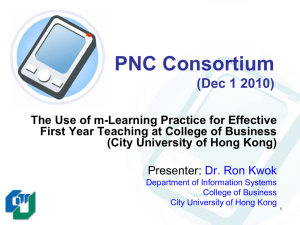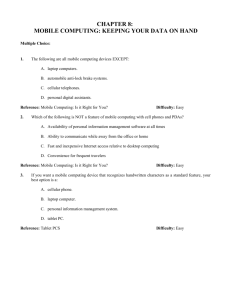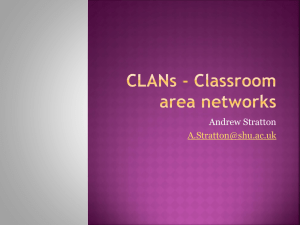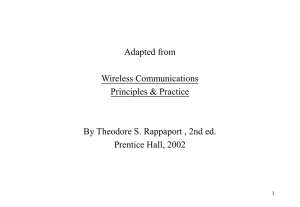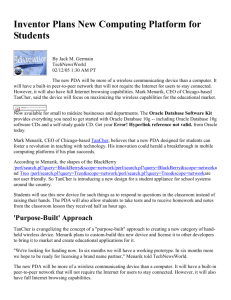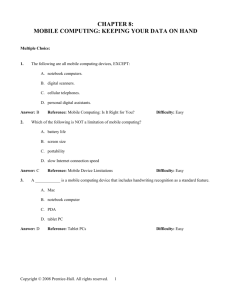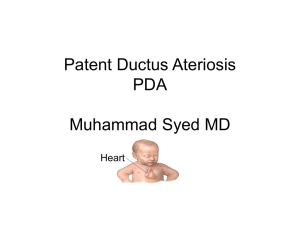Mobile Computing: How and Where to?
advertisement
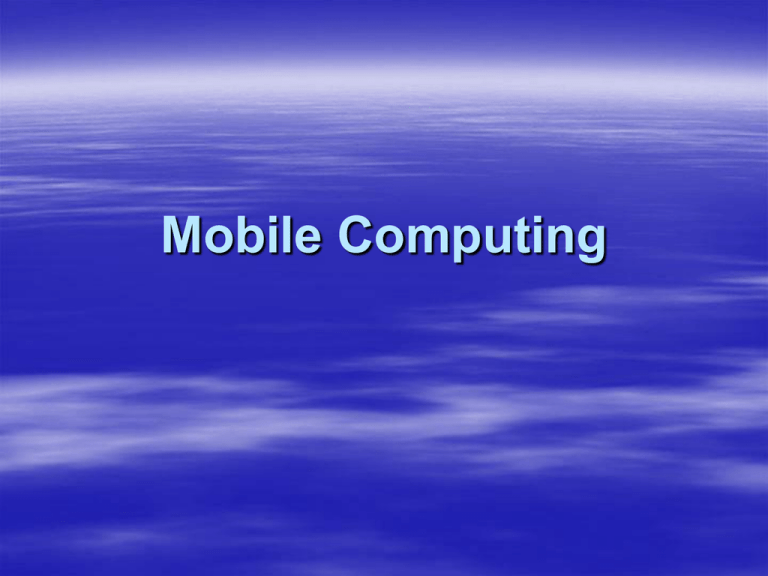
Mobile Computing
References
1- Mobile Computing: Technology, Applications
and Service Creation
By: Talukder and Yavagal
2- Mobile Computing Principles
By: Reza B’Far
3- Mobile-IP Design principles and Practices
By: PerkinsT.
4- Mobile Computing
By: Imielinski and H. Korth
Topics
1- What is Mobile Computing?
2- Mobile computing Devices
3- Mobile Computing Architechture
4- Emerging Technologies
5- Communication Networks
Mobile Computing:
How and Where to?
Lecture (1)
What is Mobile Computing
Definitions – Mobile Computing
What is mobile computing?
– Computing that is not obstructed while the location of
it changes
Mobile computing =
+
?
Mobile computing draws from
– Wireless communications and networking
Ability to communicate via wireless links
– Ubiquitous and pervasive computing
Ability to provide computing anywhere and anytime
(ubiquitous), usually in a seamless manner, potentially not
perceived (pervasive)
So What is Mobile Computing?
Computing on the go!!
How do we achieve it?
GO WIRELESS
Wireless Communications
First thing that comes in mind that has anything to do
with wireless is …
RADIO!
Radios are Listeners not Speakers !
Radio signals received in Limited Area
Radios use various frequencies
Radio Communication is Analog
So HOW TO send
Digital data on {Analog / Digital} Signal?
Wireless Communications
We need devices that
– Can Transmit (Tx) & Receive (Rx)
– Can Interpret Analog signal
– Can convert Analog signal to Digital data
– Can send and receive signal in some Area
– Can connect to other devices in this Area
– Can stay connected while moving
– Would have “enough” bandwidth for Tx
YES… We have them!
Wireless Communications
Devices operate on various Frequencies
Two devices can “Talk” on same Frequency
Many devices need many frequencies
Band of frequencies
LF
Freq 105
(Hz)
MF
HF
VHF
UHF SHF
EHF
106
107
108
109
1011
1010
Ubiquitous, Mobile, Nomadic
Terminology not always consistent
– Nomadic computing: “portable”; no mobility
while connected
– Mobile computing: “on-the-go”, e.g., while
sitting on a train; possibility of network
connections remaining open
– Pervasive or Ubiquitous computing:
computing everywhere… OR
computers everywhere…most of them
invisible
How to achieve ubiquity?
Make computing available beyond desktop
Make it mobile and connected
Instrument the person
Instrument the physical surroundings
Related areas
Pervasive computing
Wearable computing
Intelligent environments
Augmented reality
All will be referred to by umbrella term of
Ubiquitous Computing (ubicomp)
Computers Everywhere
Marc Weiser
Vision of ubiquitous computing: hundreds of
computers per person, various sizes and
capabilities
Tabs
–
–
–
–
very small--smart badge w/ user info, etc.
allow personalized settings to follow a user
leave bios behind at meetings
attached to virtually everything--e.g., books, car
keys, etc.
Reality
Some of Weiser’s H/W predictions
– Large displays, a fraction of a centimeter thick, powered
continuously for days on a small battery (no, no, no!)
– 1GHz processors (yes, yes, yes)
– 16MB of memory on a single unit (easy, memory is far
cheaper than we could have imagined in 1991)
– Several GB of storage easily available (yes: we’ve done
better than this)
So, we’re behind in displays, batteries
Mobile Computing:
Is it Right for You?
Advantages
Convenience
Boost productivity
Communicate with others
anywhere
Access to electronic
information
Limitations
Expensive
Battery life
Small screen display
Slow Internet speed
Mobile Computing Devices
Pagers
Cellular phones
MP3 players
Personal digital
assistants
Tablet PCs
Laptop computers
Comparing Mobile Devices
Mobile Devices: Price, Size, Weight, and Capabilities
Device
Relative Price
Approximate
Size
Approximate
Weight
Standard Capabilities
Paging Device
$ (includes cost for the
pager
and a monthly plan)
2" × 2" × 0.5"
0.2 lbs.
Provides numeric and/or text
messaging in one or two directions
Cell Phone
$$ (includes cost for the
phone, a monthly plan,
and Internet access)
5" × 2" × 0.5".
0.25 lbs
Provides voice and e-mail
connectivity
MP3 Player
$$–$$$
3" × 2" × 1"
0.25 lbs.
Provides storage of digital music files
and other data
PDA
$$–$$$
5" × 3" × 1"
0.5 lbs.
Provides PIM capabilities, access to
application software, and access
to the Internet
Tablet PC
$$$$$
10" × 8" × 1"
3 lbs.
Provides PIM capabilities, access to
application software, access to the
Internet, and special handwriting and
speech-recognition capabilities
Laptop
$$$$–$$$$$
10" × 13" × 2"
5 to 8 lbs.
Provides all the capabilities of a desktop
computer while also being portable
Paging Devices
Small wireless devices that receive
numeric messages (phone
numbers)
Recent technological advancements
enable:
– Voice paging:
Receiving voice messages
– Alphanumeric paging:
Receiving numeric and text messages
– Two-way paging:
Receiving and sending text messages
Cellular Phones
Full-featured communication and information
storage devices
Features include:
–
–
–
–
–
–
–
Auto-redial
Call timers
Voice-mail
Voice-activated dialing
Internet access
Text messaging
Personal information management
Cell Phone Hardware
Microprocessor (CPU):
– Coordinates data between components
– Runs the operating system
Memory
Memory:
– ROM stores the operating system
– Internal memory chips store:
Contact data
Ring tones
Images
Small application programs
Microprocessor
Cell Phone Hardware
Input devices:
– Microphone
– Keypad
– Graffiti pad
– Touch-screen
– Digital camera
Speaker
LCD display
Keypad
Output devices:
– Speaker
– LCD display
Microphone
Cell Phone Features
Text messaging:
– Short Message Service (SMS):
Send messages up to 160 characters
– Multimedia Message Service (MMS):
Send text, sound, images, and video clips
Internet connectivity:
– Wireless Internet service provider
– Maximum speed of 14.4 Kbps
– Micro-browser software
MP3 Players
MP3:
– Format for storing music
MP3 player:
– A small device that stores and plays music
Storage space determines the number of songs
stored:
– Memory chips 64 MB to 256 MB
– Hard drive up to 40 GB
– Sampling rate also affects
number of songs stored
MP3 Flash Memory
Used to add additional memory to MP3
players
Types of flash memory:
– Compact Flash:
64 MB to 1 GB
– Multimedia (MMC) and SmartMedia:
128 MB
– Secure Digital:
512 MB
– Sony Memory Stick:
128 MB
Podcasting
Distributing non-music MP3 files over the
Internet
Podcasts can be information, books on tape
audio plays, etc
People can listen when they wish
Personal Digital Assistants (PDAs)
Small devices that store digital information
Known as palm computers or handhelds
PDA hardware includes:
– CPU
– Operating system
– Storage capabilities
– Input/output devices
– Ports
PDA Input and Output Devices
Input devices
Touch-screen with stylus
Keyboards:
– On-screen
– Integrated
– Folding
Digital cameras
Output devices
LCD displays:
– Grayscale
– Color
PDA Processors
Popular processors:
– Motorola DragonBall
– Texas Instruments OMAP
– Intel XScale
Comparing processors:
– Speed
– Performance:
Benchmarking
– Power consumption
PDA Operating Systems
Palm OS
Uses less memory than
Pocket PC
Easy to use graphical
interface
Features include:
–
–
–
–
–
Calendar
To-do list
Contact information
Viewing Videos
Playing MP3 files
Extra application software
is available
Pocket PC
Scaled-down version of
Windows
More expensive than
Palm OS
Features include:
– PDA version of Microsoft
Word and Excel
– Viewing videos
– Playing MP3 files
Extra application software
is available
PDA Memory and Storage
ROM stores the operating
system and the basic
programs
RAM stores additional
applications and data
Flash memory is used for
additional storage
PDA File Transfer and
Synchronization
PDA files can be transferred to a
desktop using:
– Flash card readers
– Cradles
Synchronizing updates files on
both the PDA and desktop
Wireless transfers:
– IrDA
– Bluetooth
PDA Internet Connectivity
An Internet connection
requires a wireless ISP
Web pages are
accessed using
Wireless Application
Protocol (WAP)
Web clipping enables
information from Web
pages to be formatted
for PDAs
PDA Software and Accessories
Standard software:
– To-do list
– Contacts manager
– Calendar
Additional software:
– Microsoft Word and
Excel
– Games
– Tools
– References
Blueboard:
– PDA display acts as a
drawing board
– Connects to four other
PDAs
Converged Technologies
Cell phones with PDA
capability
PDAs with cell phone
capability
Handspring Treo
Sony Erricson P800
Tablet PCs
Portable computers with handwriting
recognition and speech recognition
Two monitor modes:
– Laptop
– Tablet
Tablet PC Hardware
Tablet PC hardware includes:
– CPU
– Storage capabilities
– Input/output devices
– Ports
Digital ink technology:
– Pressure sensitive screen
– Digital pen
Tablet Software
Windows XP Tablet PC is the operating system
Applications programs compatible with Windows
XP are available
Laptops
Also known as notebooks
Computing power of a desktop
Weigh 6 pounds
Laptop Hardware
DVD/CD-RW drives
Hard drives
RAM
Hot-swappable bays:
– Remove a drive and replace it
with another type
Keyboard
Built-in mouse
LCD displays
Laptop Operating Systems
Same operating systems
as those found on
desktops
Power management:
– Shuts down the hard drive
– Turns off the monitor
– Puts the computer into
standby mode
Laptop Ports
A full set of ports:
–
–
–
–
–
–
–
–
Parallel
Monitor
USB
Modem
Ethernet
Audio jacks
FireWire
PCI type I/II card slots
Lecture 1: Summary Questions
What are the advantages and limitations of
mobile computing?
Lecture 1: Summary Questions
What are the various mobile computing
devices?
Lecture 1: Summary Questions
What can pagers do?
Lecture 1: Summary Questions
How do cell phone components resemble a
traditional computer and how do cell phones
work?
Lecture 1: Summary Questions
What can I carry in an MP3 player and how
does it store data?
Lecture 1: Summary Questions
For what can I use a PDA and what internal
components and features does it have?
Lecture 1: Summary Questions
How can I synchronize my mobile devices
with my desktop computer?
Lecture 1: Summary Questions
What is a tablet PC?
Lecture 1: Summary Questions
How powerful are laptops and how do they
compare to desktop computers?
